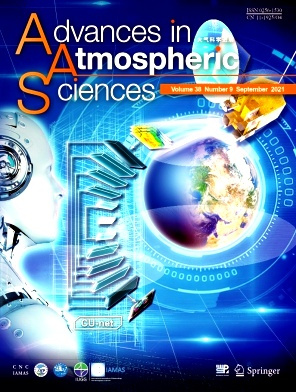Advances in Atmospheric Sciences雜志投稿須知:
1、Manuscript componentsEach manuscript should include the following components, presented in the order shown.1) Title, name, affiliation of each author and corresponding author's email provided on the title page.2) Abstract. A brief, concise abstract is required at the beginning of each manuscript. The abstract contains a brief account of the background and rationale of the work, followed by a statement of the main conclusions. The abstract is typically 250 words or less in length and is unreferenced. The abstract should be 250 words or less in length. The abstract should not contain any mathematical expressions if possible, should include no footnotes or citations, and should not contain first-person sentence structure.3) Key words. 4-6 key words should be provided.4) Text. The text (12-point) should be typesetted in one column, divided into sections, each with a separate heading and numbered consecutively using following format1. Primary heading1.1 Secondary heading1.1.1 Tertiary heading1.1.1.1 Quaternary heading5) Acknowledgements. Keep this section as brief as possible by acknowledging only direct assistance in your research and writing. Financial support for the work done should be acknowledged here rather than as footnotes to the title.6) References. References should be arranged alphabetically without numbering. Citations to standard references in text should consist of the name of the author and the year of publication—for example, Wang (1990) or (Wang, 1990). If there are three or more authors, state the first author’s surname, followed by "et al." and the year of publication—for example, Wang et al. (1990) or (Wang et al., 1990). When there are two or more papers by the same author or authors in the same year, distinguishing letters (a, b, c, etc.) should be added to the year in both the citation in text and the reference listing, for example, Wang (1990a). For multiple citations by one author, separate years by commas, for example, Wang (1989, 1990) or (Wang, 1989, 1990). Separate multiple citations by different authors within the same parentheses by semicolons, for example, (Wang, 1990; Li, 1991) or (Wang, 1989, 1990; Li, 1991).7) Figure captions. Each figure must be supplied with a self-explanatory caption and all captions should be listed together. Authors should also include captions below the figures for the reviewer copies.8) Illustrations and tables. Each figure and table should be numbered consecutively and cited specifically in the text by number. All tables should have a title or legend.。
2、FormulasBrief equations or terms set inline in text must be set as a single line expression, if possible. Also please enter them directly from the keyboard if possible. For more complex variables that have both subscripts and superscripts, or have a more complicated operator such as a radical sign, use of the MathType equation editor is recommended.。
3、ReferencesReferences should be given alphabetically without numbering at the end of the paper. References must be complete and properly formatted and only literature cited in the text can be listed.1、 For typical journal citations it follows the form:Author(s), publication year: Article title. Journal name, volume, page range.For example,Boville, B. A., and J. W. Hurrell, 1998: A comparison of the atmospheric circulations simulated by the CCM3 and CSM1. J. Climate, 11, 1327–1341.2、 For a book it follows the form:Author(s), publication year: Book Title. Publisher, total pages.For example,Pedlosky, J., 1987: Geophysical Fluid Dynamics. 2nd ed., Springer-Verlag, 710pp.3、 For a chapter in a book it follows the form:Author(s), publication year: chapter title. Book Title, Editor(s), Publisher, page range.For example,Zhang, R. H., and J. P. Chao, 1993: Mechanisms of interannual variations in a simple air-sea coupled model in the tropics. Climate Variability, D. H. Ye, et al., Eds., China Meteorological Press, Beijing, 236–244.。
4、 For a website, it follows the form: Chou, M.-D., and M. J. Suarez, 1994: An efficient thermal infrared radiation parameterization for use in general circulation model. NASA Tech. Memo. 104606, Vol. 3, 85 pp. [Available online at NASA/Goddard Space Flight Center, Code 913, Greenbelt, MD 20771.]4、FiguresVector-based figures (eps., ai., or psd.) should be provided upon acceptance of a paper.。
5、AnimationAAS accepts submission with animation. Authors can submit it as supplementary materials via ScholarOne if the video is less than 10 M. The format flv. (or mpeg, avi, etc.) is desired. If the video is more than 10 M, authors are suggested providing a URL of the video for the convenience of the reviewers. The original video can be sent to the Editorial Office upon acceptance of the paper.。
6、Copyright informationAs a member of Committee on Publication Ethics (COPE), Advances in Atmospheric Sciences conforms to Code of Conducts and Guidelines of the Committee on Publication Ethics and is committed to publishing original work by the named author or authors.As soon as an article is submitted, authors will be requested to assign copyright of the article (or to grant exclusive publication and dissemination rights) to the publisher (respective the owner if other than Springer). This will ensure the widest possible protection and dissemination of information under copyright laws.
Advances in Atmospheric Sciences數(shù)據(jù)分析
影響因子:指該期刊近兩年文獻的平均被引用率,即該期刊前兩年論文在評價當年每篇論文被引用的平均次數(shù)
被引半衰期:衡量期刊老化速度快慢的一種指標,指某一期刊論文在某年被引用的全部次數(shù)中,較新的一半被引論文刊載的時間跨度
他引率:期刊被他刊引用的次數(shù)占該刊總被引次數(shù)的比例用以測度某期刊學術(shù)交流的廣度、專業(yè)面的寬窄以及學科的交叉程度
引用半衰期:指某種期刊在某年中所引用的全部參考文獻中較新的一半是在最近多少年時段內(nèi)刊載的
平均引文數(shù):在給定的時間內(nèi),期刊篇均參考文獻量,用以測度期刊的平均引文水平,考察期刊吸收信息的能力以及科學交流程度的高低
熱門評論
谷梁*** :
總體還是蠻快的。感覺雜志非常正規(guī)專業(yè),審稿專家給出的修改建議都很有價值,編輯對格式的要求很高,很高興投了本雜志,希望《Advances in Atmospheric Sciences》越辦越好。
劉*** :
Advances in Atmospheric Sciences的編輯,非常負責任,而且修改意見寫得也非常詳細明確,本人覺得該期刊在國內(nèi)來說,專業(yè)、負責,發(fā)展會越來越好的。感覺不是很難發(fā)表的,只要是符合該刊物的要求有一定的新意即可。
西門*** :
已投多次修改后錄用,審稿周期較快,1個月錄用,專家所提意見很到位也很詳細。本人普通院校小碩一枚,第一次投該雜志(因看大家對該刊評論較好),另有多名同學也投過該雜志,都是修改后錄用,該刊十分重視論文格式,希望對打擊有幫助!
韋*** :
雜志的處理速度還是很快的,審稿流程也非常規(guī)范,不會讓作者盲目等候。審稿人比較嚴謹,意見非常犀利,提出來的問題很好,讓我有更深入的思考。提了10多個問題,對提升文章檔次很有幫助!
左丘*** :
編輯部老師的態(tài)度每次都非常好。郵件回復也很快。1個月零7天后就可以催稿,而且該期刊是歡迎催告。建議關(guān)注Advances in Atmospheric Sciences的新浪微博,通過上面的談?wù)摚梢詫φ麄€投稿過程有個更清晰的了解。
麻*** :
Advances in Atmospheric Sciences審稿速度也快,最近投了一篇3個月內(nèi)錄用了,外審7天修回,然后自己拖了一個星期給修回編輯后過兩天就錄用了。
吳銘*** :
我是.12月12日投稿,修改意見是12月23日回來的,提的意見很中肯, 27日修改后直接錄用~版面費有點貴 但是速度還是可以的 就是不知道發(fā)表是什么時候了
谷梁*** :
兩個外審按時返回意見,外審兩個月了都還沒回信,給編輯部打電話,第一次說催下,確實催了有效果,給了我的修改意見,改了就錄用了。Advances in Atmospheric Sciences要求文章要有創(chuàng)新,有自己的東西,行文要流暢,盡量避免錯字、歧義語句。
貫丘*** :
我沒發(fā)現(xiàn)編輯部態(tài)度好,我有篇文章初審超過2個月,打電話咨詢下為什么初審這么久,那編輯很不耐煩,說讓等,態(tài)度相當不好。。。感覺說話的語氣像欠她錢一樣,暈慘了。
南宮*** :
首先編輯人很好。投稿后需要自己電話咨詢稿件狀態(tài),如果文章有基金支持有很大被錄用的可能,見刊也很快,一般來說都是3個月。版面費有點小貴。希望以后越辦越好。
